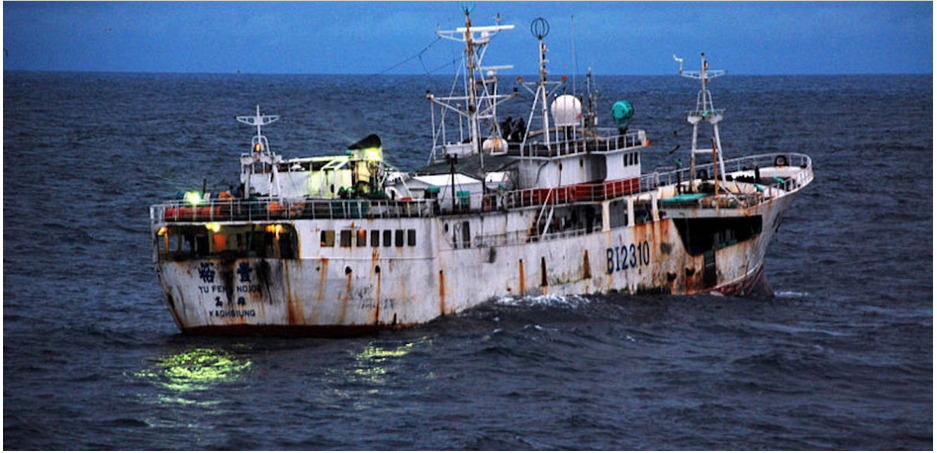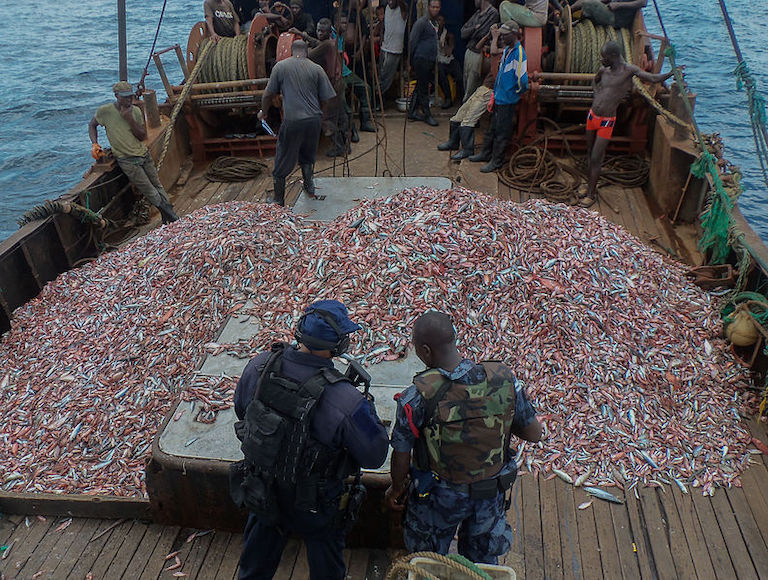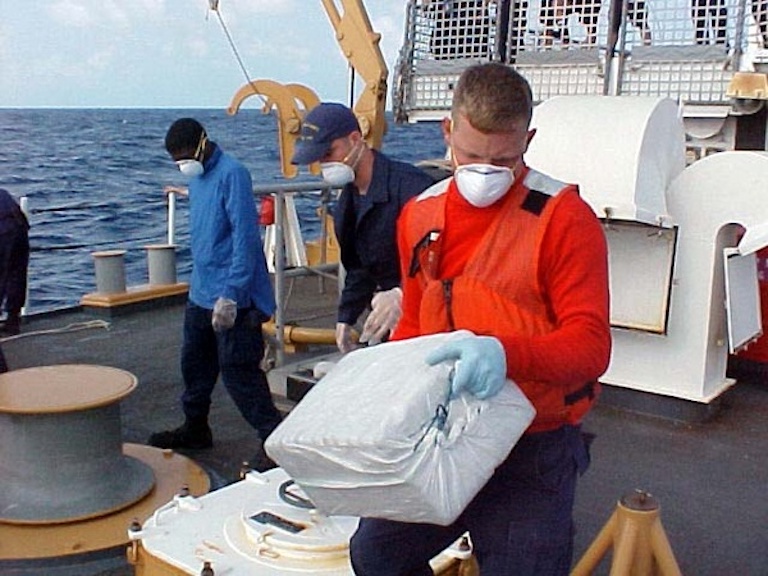Drug trafficking could be putting ‘fragile fisheries’ at risk, study says
July 09, 2020By Elizabeth Claire Alberts
|

|
- A new study found that fishing vessels are increasingly being used to traffic drugs, tripling over the past eight years, and accounting for 15% of the global retail value of illegal drugs.
- Small-scale fishermen commonly get involved in the drug trade, possibly due to collapsing fish stocks and strict conservation measures threatening their livelihoods, or because they have been coerced.
- While most fishing vessels carrying drugs don’t appear to be involved in other maritime crimes like illegal fishing, drug traders may reinvest profits into illegal fishing activities, which could lead to fisheries collapse and environmental destruction.
- The COVID-19 pandemic may intensify the issue of drug trafficking on small fishing vessels due to global economic stress, and maritime routes currently being more accessible than land route
The fishing boat flew a Singaporean flag as it sailed toward Batam Island in Indonesia. But when Indonesian Navy officers intercepted the vessel and boarded it in February 2018, they discovered that the boat, and its four-person crew, were actually from Taiwan. Flying a false flag wasn’t the only offense — customs officials also found 41 rice sacks packed with a ton of methamphetamine, or crystal meth, hidden beneath food supplies in the vessel’s hold.
The use of fishing vessels to transport drugs is a fairly common occurrence, according to a new study published in Fish and Fisheries. In fact, the study found that drug trafficking on fishing vessels has actually tripled over the last eight years, accounting for about 15% of the global retail value of illicit drugs.

Authorities board and take control of one of two wooden dhows found loaded with heroin and methamphetamines in December 2003. Image by U.S. Navy.
Dyhia Belhabib, the paper’s lead author as well as the principal fisheries investigator at Ecotrust Canada and founder of Spyglass, an online tool that maps out vessels involved in maritime crimes, said there’s actually a distinct lack of data on drug trafficking in the fisheries sector. This study aimed to bridge that gap.
To investigate the relationship between the drug trade and global fisheries, Belhabib and her co-researchers gathered all of the available data on 292 reported global cases between 2010 and 2017, and used estimation techniques to fill in any missing information. For instance, when they had the amount of drugs, but not the price, they calculated prices based on data on the United Nations Office on Drugs and Crime (UNODC) database.
“The second step was to use what we call a Monte Carlo approach,” Belhabib told Mongabay. “We simulate how much of that is caught versus how much it has never been caught … because there was no monitoring or because monitored has failed in catching them… and with that, the amount, and the price, we actually infer the maximum value of drugs that could be in circulation to the seafood sector, and … the average between that maximum value and minimum value gives you an estimated 15%.”
When Belhabib began her research, she said she expected to find vessels trafficking drugs to also be involved in other maritime crimes like illegal fishing, but this didn’t turn out to be the case. One possible explanation is that drug traffickers may want “clean vessels that have not been involved in anything before,” so they don’t raise suspicion with coast guard or navy officials when entering territorial waters, Belhabib said.

Belhabib and her co-investigators also found that drug trafficking tended to involve small vessels, such as dhows, pangas, pirogues and artisanal boats, rather than larger, industrial fishing vessels. While the study says more research needs to be done to understand the reasons for why small-scale fishermen get involved in the drug trade, it surmises that collapsing fish stocks and marine conservation measures like fishing restrictions could be pushing them in this direction. In other instances, drug traffickers will threaten fishermen to cooperate or even hijack their vessels. With this in mind, Belhabib said it’s important not to implicate the fishermen who may have unwillingly gotten involved in the trade.
“We don’t want to criminalize people, just because they were busted with drugs on board,” Belhabib said.
When law enforcement officials do arrest fishermen involved in drug trafficking, this doesn’t necessarily get rid of the problem, Belhabib said. By using small boats, drug traffickers may spread the “risk” across several vessels, so if one gets intercepted, the traffickers won’t lose that much money. And in many cases, a drug interdiction simply raises the price of the drugs, and drug cartels may divert their shipments to new or alternative routes, the paper suggests.
“You know those spiders that have baby spiders in their bellies, and what happens when you crush them?” Belhabib said. “When you crush them, all of the baby spiders are going to spread. So you killed one spider, but you have dozens of baby spiders. That’s a major problem because you’re going to have trouble catching them, and that’s a pretty good metaphor when it comes to enforcement … around drug trafficking.”

While fishermen themselves may not be involved in illegal fishing, drug money may be reinvested into large-scale illegal, unreported and unregulation (IUU) fishing activities, which may lead to unsustainable fishing and entire fisheries collapse, the study suggests.
“So far, there is anecdotal evidence that some profits have been laundered in this way, with for example cases of Colombian, Mexican and Panamanian drug dealers who had re-invested in fishing, in part to run their smuggling activities,” the authors write in the paper. “From an organized crime perspective, there is a need to better identify drug cartels that are specifically using their criminal and networks skills to pursue illicit fishing activities.”
David Wrathall, a co-author of the study and assistant professor of geography, environmental sciences and marine resource management at Oregon State University, said the relationship between drug trafficking and over-capitalization of fish stocks shines a light on an “important new problem.”
“For a decade, I’ve been involved in research showing how drug trafficking pumps astronomical sums of money into cattle ranching in fragile forested areas,” Wrathall said in a statement. “Drug trafficking has become a major cause of deforestation in transit countries. This paper tells us a similar story — that drug trafficking is pumping money into fragile fisheries.”
The COVID-19 pandemic could further exacerbate these problems, according to Philippe Le Billon, the study’s other co-author and professor at the University of British Columbia’s Department of Geography and Liu Institute for Global Issues.

“Artisanal fishers have lost income during COVID-19 confinement and restaurant closures,” Le Billon said in a statement. “I am afraid this will make them more vulnerable to drug smuggling networks.”
With land routes disrupted in many parts of the world, traders may also be favoring maritime routes to transport drugs, so there is likely to be an increase in drug trafficking on small boats during the pandemic.
“I think with COVID-19, the problem may grow,” said Belhabib, adding that policing has gone down in many jurisdictions due to the pandemic. “Maybe we will not have more actors on the water, but we will have more frequency because there’s less policing in the water.”
courtesy : news.mongabay.com